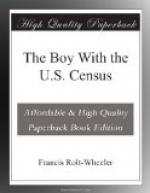“Walk in, sah, walk right in,” he said. “Ah’ll sen’ one o’ the boys to look after yo’ horse. Tom!” he called, “yo’ take the gen’leman’s horse to the stable, rub him down with a wisp, an’ give him some hay. In half an hour water him, an’ give him a feed o’ oats.”
“I’m obliged to you,” said Hamilton, “for taking all this trouble, but perhaps I had better explain who I am.”
“That’s jes’ as yo’ like, sah.”
“Well,” said Hamilton, “I’m the census-taker for this district, and I was looking for a hotel where I could stay the night and begin work in the morning. A man I met on the street told me that this town had no hotel and suggested that if I came to you, I might be advised where to go.”
“We have no hotel in Bullertown, sah,” the old negro preacher answered, “but the gen’lemen that come hyar do me the honor us’ally, sah, of bein’ my guests. Ah have a guest-room, sah, jes’ ‘sclusively fo’ gen’lemen who are not people of color.”
Hamilton found himself flushing at the consciousness that this very thought had been in his mind, and in order to cover any possible signs that might have appeared in his expression, he answered hastily:
“Oh, that’s all right,—it wouldn’t have mattered.”
The old preacher looked at him quietly and a little reproachfully and said:
“If you don’ jes’ mean things like that, young sah, don’ say them. We know. We find, sah, that it is mos’ desirable for every one concerned. If yo’ like, sah, an’ if yo’re ready, Ah’ll show yo’ to yo’r room.”
[Illustration: IN AN ALL-NEGRO TOWN. Residents of Bullertown on the day that the census was taken. (Brown Bros.)]
[Illustration: IN AN ALL-NEGRO TOWN. Residents of Bullertown on the day that the census was taken. (Brown Bros.)]
Hamilton could not help contrasting this reception with that which he would have received in any town not entirely a negro community, and he expressed this feeling to his host as they went up the stairs.
“It is entirely different hyar, sah,” the latter said, “yo’ see we are isolated, an’ a guest is rare. Then this community is a syndicate an’ is not run like a town. Thar’s no quest’n hyar, sah, about colored and white people bein’ the same,—we know they’re different. An’ we believe, sah, that it is in preservin’ the color line, not in tryin’ to hide it, that the future good of our race lies. An’ so thar’s not a foot o’ land in Bullertown owned by any other than people o’ color, an’ not a white person lives hyar.”
“You own all the land, then?”
“The syndicate does, yes, sah.”
“Then you must have some wealthy men among you?”
“No, sah, not one. The town was begun, sah, by the kindness of Colonel Egerius.”
“Colonel—he was, that is, he is—” began Hamilton, stammering.
“He is not a negro, sah,” the old man answered finishing the boy’s embarrassed sentence for him with entire self-possession. “Colonel Egerius, sah, was a plantation owner, befo’ the war. Ah was one o’ his slaves, an’ mos’ o’ the people in Bullertown are the children o’ those born in the plantation quarters.”




